Flounder fishing enjoys a stellar reputation among anglers for several good reasons. First of all, they are widespread and relatively common throughout their range. But best of all, they eagerly hit a variety of baits, both natural and artificial. But they also offer their own challenges. Experts at the game all have their favorite flounder techniques, so if you want to learn how to catch flounder, it pays to listen to their advice, whether it’s for the best flounder rigs, the best baits and lures for flounder, or when and how to find and catch them.
We spoke with some of the best flounder fishing experts around to find out their tips on how to catch flounder. Fishing for flounder isn’t rocket science, but it’s better to go into it knowing a few tricks and techniques if it can give you an edge out on the water. Techniques for flounder vary from drifting live or cut baits along the bottom to working an artificial through the water column. Primary techniques involve getting your bait or lure on the bottom: that’s where flounder live and feed for most of their lives.
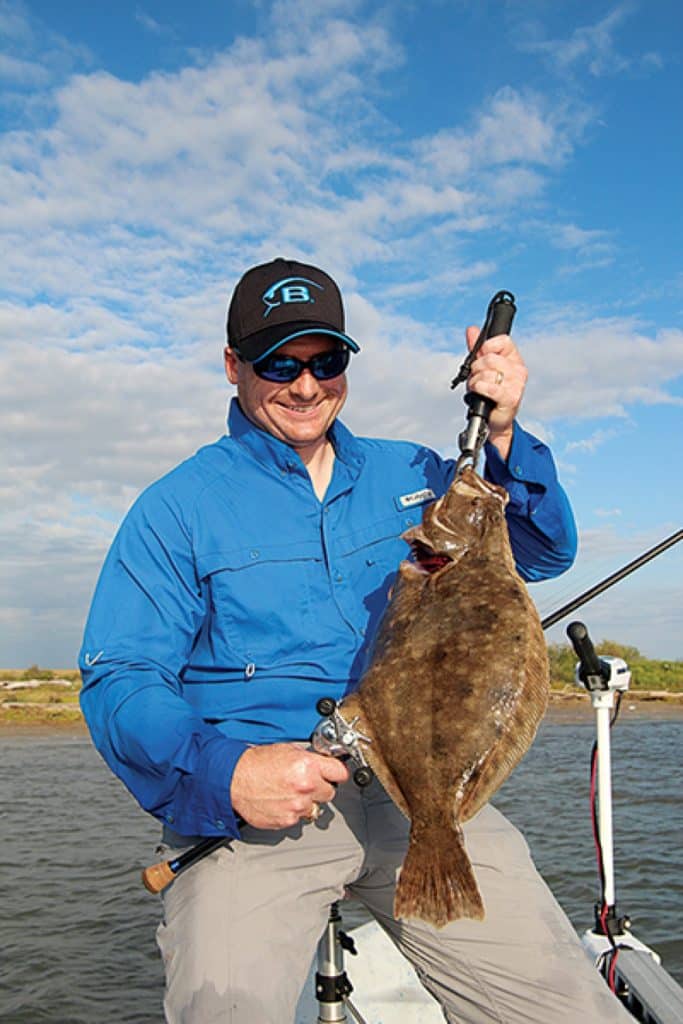
Fishing Ledges to Catch Flounder
Jake Markris of Fairhope, Alabama, is a die-hard flounder fisherman. His flounder rig setup typically entails light tackle and mainly 1/4-ounce jigs, and his specialty is working sandbar drop-offs and small, inshore ledges that many anglers overlook. “Flounder relate to the slightest drop-off, sometimes only six or eight inches, and a one- or two-foot ledge can be a real fish magnet,” he explains. “I use a boat to get to prime fishing locations, but I find that wading is often the best way to approach flounder in shallow water. Wading doesn’t spook the fish, and you can use your feet to feel for the little drop-offs that often hold fish.”
Jake fan-casts to these drop-off areas, probing the bottom with jigs as his first choice for flounder lures. Casts made parallel to the ledge are often most productive because the lure is kept in the strike zone throughout the entire retrieve. Jake also points out that ledges are best fished when the current is flowing from shallow to deep. In this scenario, flounder often gather on the deep side of the ledge, waiting for bait to be swept off the shallow flats.
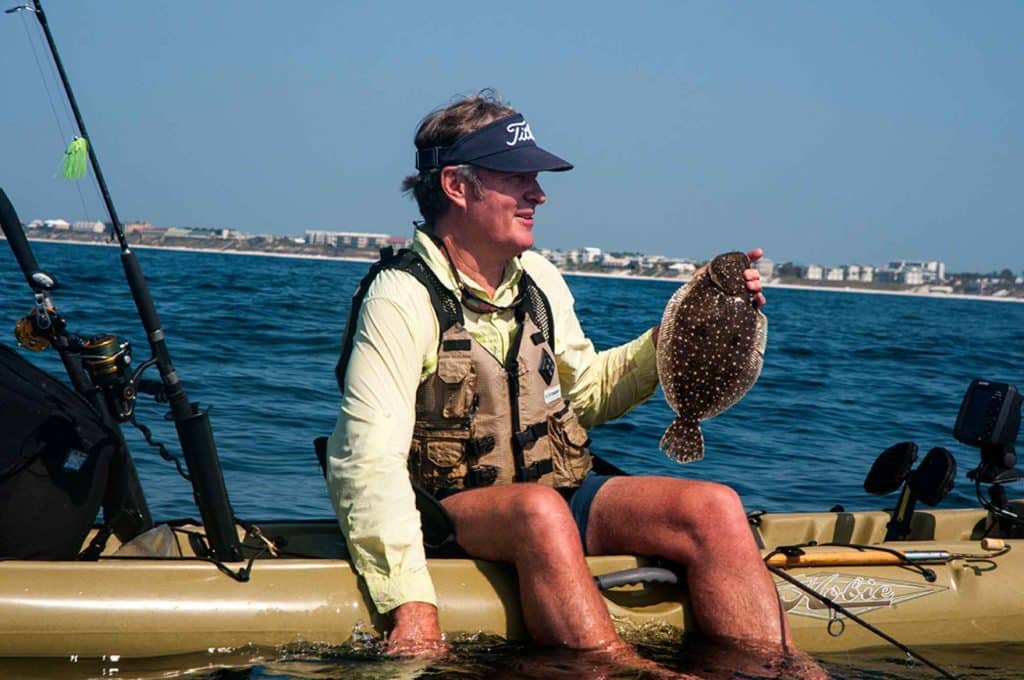
How to Find Flounder
Guide Greg Fields of Atlantic Beach, Florida, first learned about what he calls “flounder tracks” while wading the shallow mud and sand flats at low tide in search of live bait. He noticed that the bays which held the most bait when the tide dropped also had a large number of flounder outlines on the bottom. As the tide receded, flounder that had been lying buried in the bottom pulled out, leaving their body imprints, and that gave Fields a good idea of where to look for them when the tide came back in. “I’ve located a number of hot spots while walking mud bars at low tide,” he explains. “A flounder track stands out remarkably well, and it’s a sure sign that the spot holds fish when the water is high.”

Best Flounder Rigs
The “flicker rig” is simply a modified version of the standard fish-finder rig, which many flounder fishing anglers use for working live baits. It’s especially popular with North Carolina flounder fishermen, including Captain Booger Harris of Pantego. Like the basic fish-finder, this flounder fishing rig begins with the fishing line running through an egg, bullet or flat sinker, which is then tied to a barrel swivel. Next, a two-foot section of mono that’s lighter than the main line is tied to the opposite end of the barrel swivel. Roughly one foot from the leader end, a bright-colored foam or cork float is positioned. Some floats have plastic “stoppers” at their ends for sure positioning, and yellow or red floats are preferred. A couple of small, red, plastic beads are threaded onto the leader, followed by a small, chrome or brass spinnerblade. Many anglers prefer Colorado blades because they give off a lot of flounder-attracting vibration, but willow-leaf or Indiana blades can be used as well.
A clevis can be used to facilitate the spinning action of the blade. Lastly, thread a couple more plastic beads onto the leader and tie on a suitable hook, such as a 1/0 Kahle. The float keeps the bait off the bottom, where it’s more vulnerable and easily seen by fish. Furthermore, the float’s bright color serves to attract flounder, as does the spinnerblade. The beads allow the spinnerblade to turn freely on the fishing line without binding against the hook, cork or tangling in the line.
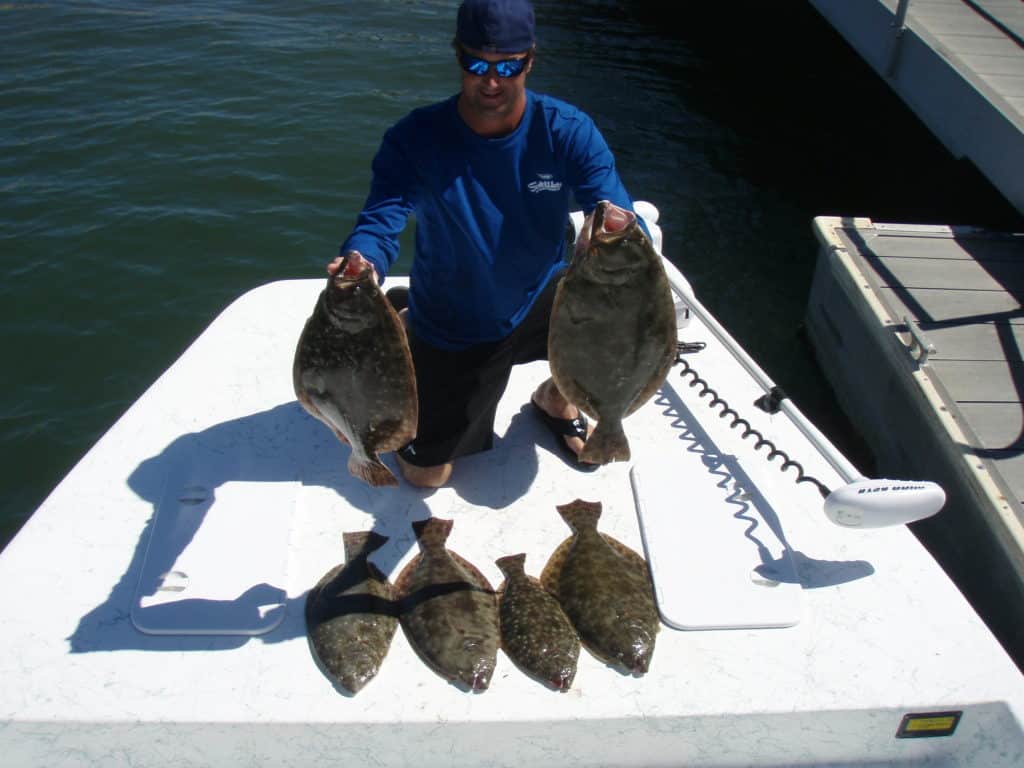
Catching Flounder Close to the Boat
“About half the flounder I catch are taken less than a rod length from my boat,” guide Bo Hamilton, of Ocean Springs, Mississippi, says. “Flounder often don’t take a bait or lure right away, but follow it during the retrieve. When flounder do this, they usually settle to the bottom, right under the boat. Therefore, it’s a good idea to periodically work a jig or bait directly under the skiff. It’s amazing how many flounder can be caught this way. Sometimes it takes several tries, but if there’s a flounder down there, it can be made to strike by repeatedly dropping a jig or natural bait in front of it.”
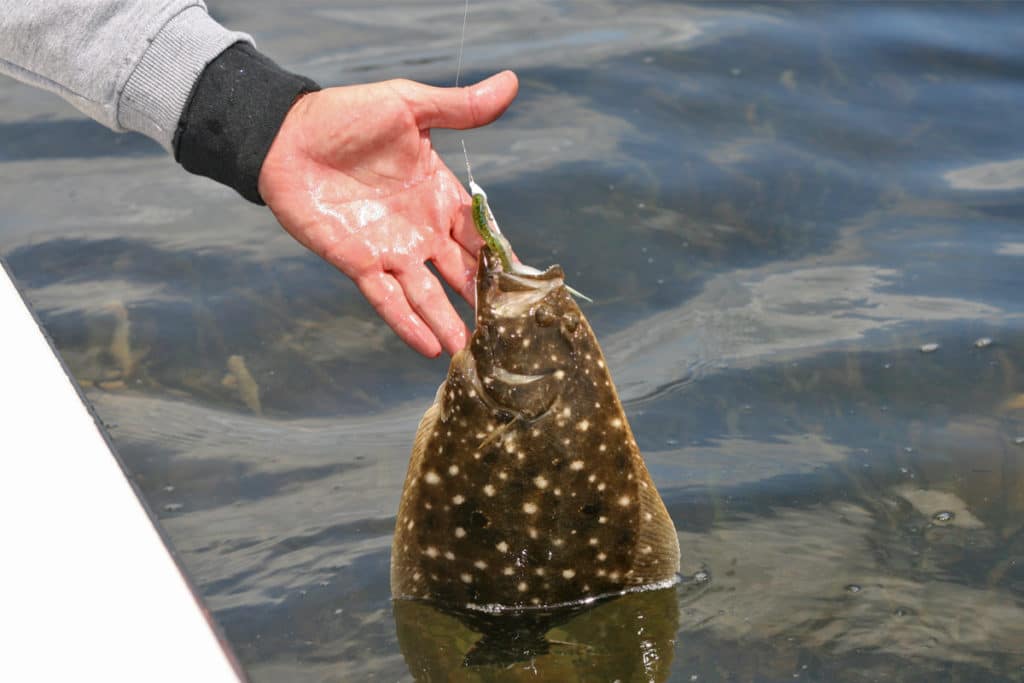
Creek Fishing for Flounder
According to guide Mark Noble of Brunswick, Georgia, the myriad creeks that feed into bays, bayous, rivers, sounds and the Intracoastal Waterway offer prime, largely untapped flounder action.”
Chasing creek flounder is classic ‘spot’ angling, meaning that a certain spot will frequently yield several fish in short order,” says Mark. “Falling tides are normally best, and almost any creek run-out can hold fish. The best run-outs are often located near deep creek bends. Frequently, a creek bend that has several run-outs pouring in from different directions will hold a particularly large number of flounder. “If I hook a fish or two, I’ll frequently ease over a lightweight anchor or nose the skiff into the marsh until the area is completely and thoroughly worked. But I never fish a place too long. I prefer to keep moving during the falling tide. The key to success is covering the water quickly, quietly and efficiently.
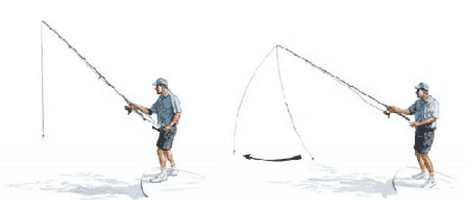
Casting Techniques for Flounder
Flippin’ is a technique that allows anglers to fish heavy cover. While normally used for freshwater bass, some inshore fishermen have found that flippin’ is a great flounder fishing technique for hard-to-reach spots.”Flippin’ for flounder is essentially the same as flip-pin’ for bass,” says Ray Thomas, a respected Mandarin, Florida, taxidermist and dedicated flounder fisherman. “I prefer a seven-foot spinning outfit for this work, and use it almost like a fly rod at close range. I pull line through the rod guides with my left hand as I’m raising the lure and line from the water with the rod. I’ll flip the lure out, then jig it around the boat, because I anchor near good flounder structure such as pilings, bulkheads and jetties. These places are full of barnacles, and it’s easy to get cut off. But when you keep your casts short by flippin’, you can work these hot spots quickly without getting hung up.”
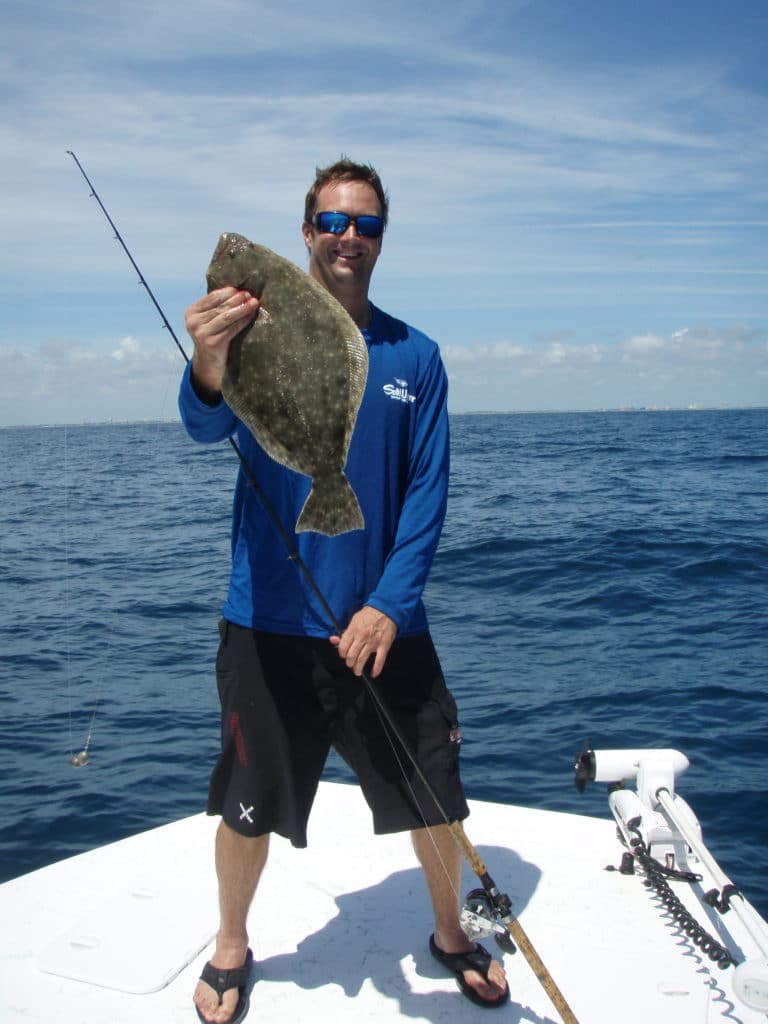
Drift for Flounder
Guide Larry Miniard, of Ponte Vedra, Florida, says one of the best ways to catch flounder and learn a fishing area at the same time is to drift or “bump troll.” “The first time I fish a new area for flounder, I like to have the current or tide push my boat along so I can cover a lot of water at a pretty good clip,” he explains. “I’ll find a likely area, such as a jetty edge, rolling bottom or set of old pilings, and run upcurrent. Then I’ll turn the boat broadside to the flow and simply drift along. “Using bottom-bumping live-bait rigs or jigs is deadly, and I use my electric motor to hold the boat in position. Done right, I can cover a lot of water in a hurry, especially if there are three or four anglers onboard. It’s a superb way to investigate a creek or small river, because you can just about cover the entire width of the waterway in one drift.” When the current and/or wind is not favorable for drifting, Larry “bump trolls” by using his electric motor or outboard to push him along, covering water until he locates fish.
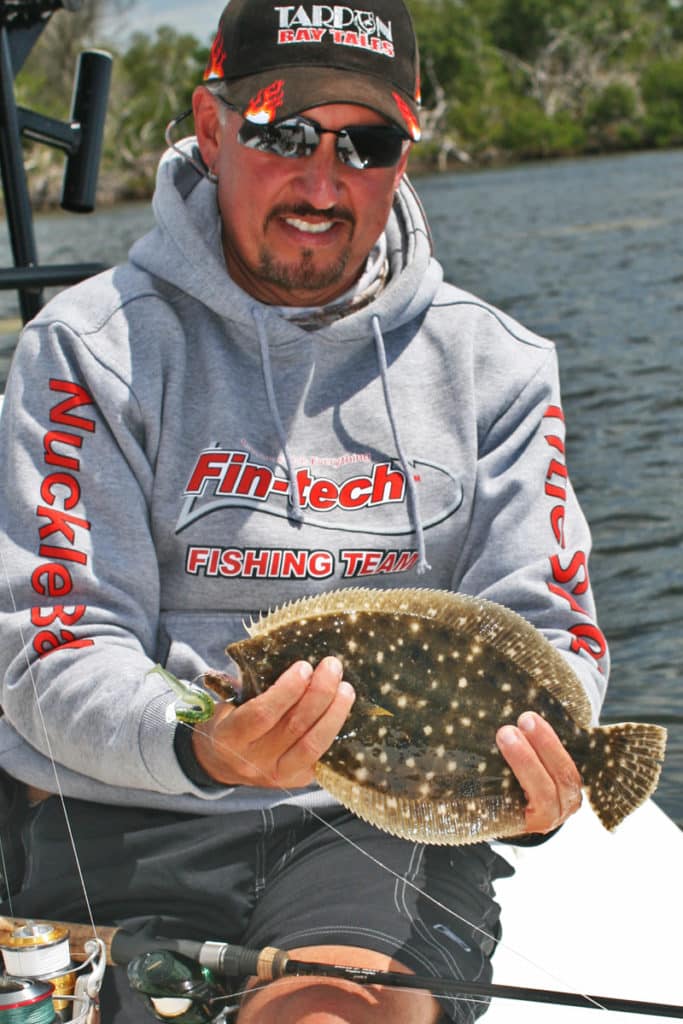
Flounder Like Live Bait
Guide Kirk Stansel of Hackberry, Louisiana, says that a great way to catch more flounder is to always keep your bait moving. This will help you locate any rocks and pilings on the bottom, plus it presents the bait in a natural way. “Flounder usually wait for a bait to come to them.” Kirk explains. “So it’s important to keep your bait moving.” Kirk also has a trick for catching flounder around line-cutting structure. “Many times when a flounder hits a bait in a really tough tangle of pilings or rocks, it’s possible to gently lead the fish away from the cover before setting the hook. When a flounder wants a bait, you almost can’t pull it away from him. So when it strikes a bait in a tricky spot, such as under a dock, just slowly reel in line and lead the fish to a place where it can be played without the risk of a cut-off.”
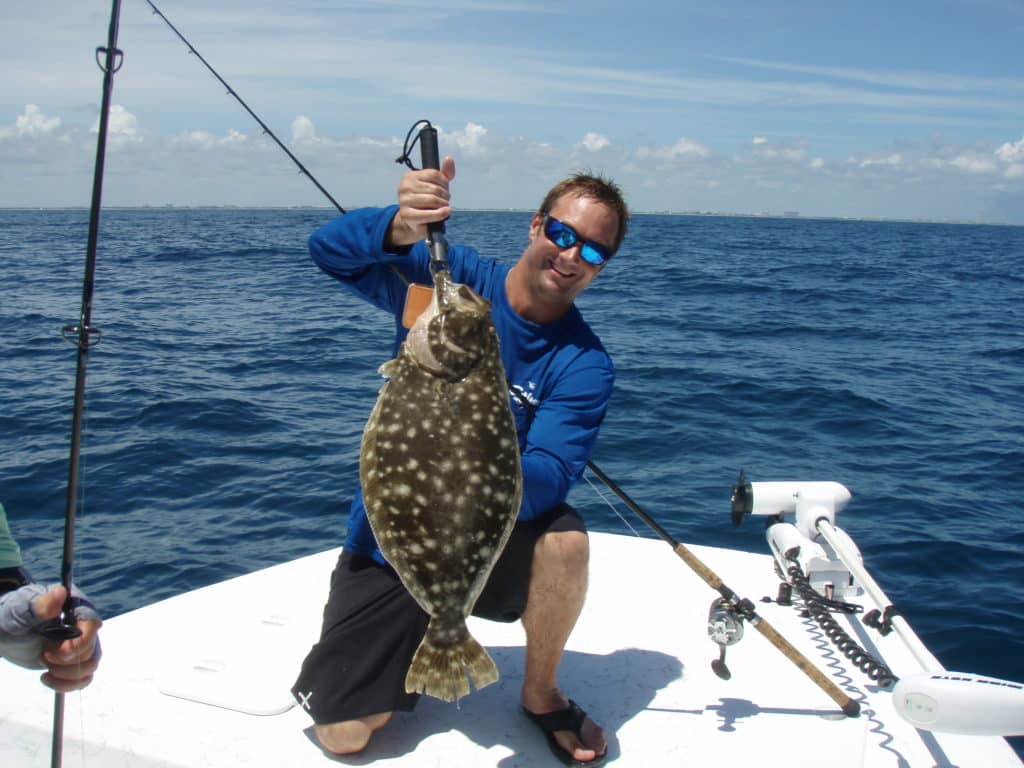
Where to Catch Flounder
Location is one of the biggest factors when trying to catch flounder, and along with the season determines where you’ll find fish. Time of year, spring, summer, fall, or winter, combined with the part of the country you’re fishing, determines the success of your time on the water.
Flounder inhabit nearshore waters from Maine to the Gulf Coast. The best flounder fishing on the east coast takes place in New Jersey, North Carolina, and Florida. The best flounder fishing spots in Florida run from the Jacksonville area to the Central Florida coast. Along the Gulf Coast you’ll find hot fishing in both Louisiana and Texas.
An important key to successful flounder fishing is familiarity with the area, according to top inshore angler Kim Norton, a Mississippi native who now works as a tackle buyer for Cabela’s. “When I first started flounder fishing, I picked a place inside an inlet where I knew other anglers consistently caught flounder,” Kim recalls. “I was determined to learn a half-mile section of that inlet shoreline better than anyone else. In time, I learned every foot of it. By fishing jigs and bottom-bumping baits, and by checking the area repeatedly with a very sensitive depthsounder, I got to know that water in just a season of fishing.
“Too many anglers rely solely on their depthsounder to show them the location of rocks and drop-offs where flounder might hold. But by slowly fishing jigs and/or live bait on a standard fish-finder rig, you learn a lot more about the bottom. This is especially true when using low-stretch braided line. With experience, you’ll be able to feel whether the bottom consists of mud, sand, oyster shell or rock. This will help you locate the best flounder-holding places. “It’s important to understand that flounder are an ambush-type fish. They hold near structure, and when you find structure by feeling it with bottom-bumping lures and bait rigs, you’ll learn where to focus your fishing efforts – and put more fish in the boat as a result.”
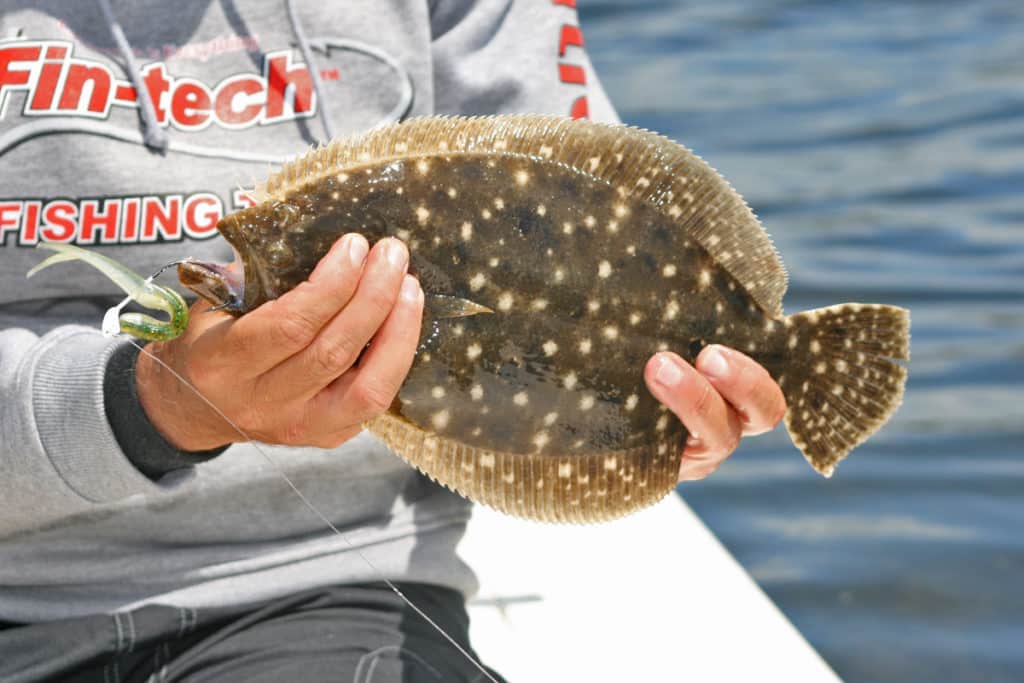
Best Baits for Flounder Fishing
Serious flounder pros such as guide Mark Dushane of Summerville, South Carolina, say that live baitfish are numero uno for flatfish. Almost any type of small baitfish will work, but flounder can be selective, and you never know what they’ll want until you start fishing. For this reason, Mark prefers to catch his own baitfish at low tide from salt creeks and marshes. He’ll use a wide variety of baitfish, but the best bait for flounder include mullet, menhaden, croakers, spot and mud minnows (killifish). Shrimp work for flounder, too, according to Mark, but take a back seat to minnows. Large baits (three to four inches long), which are best for big flounder, are hooked through the lips, smaller baits through the eyes.
The bait is cast to the edges of jetties, pilings, bulkheads and other structure before being retrieved ever so slowly. When it comes to artificial baits, Mark likes white, pink, smoke, silver and yellow grub-tailed jigs, especially curly-tail models. Sometimes tipping a grub jig with a piece of natural bait will tempt a reluctant flounder into striking. Strip baits made from small mullet or other baitfish can be very good on jigs, too.









